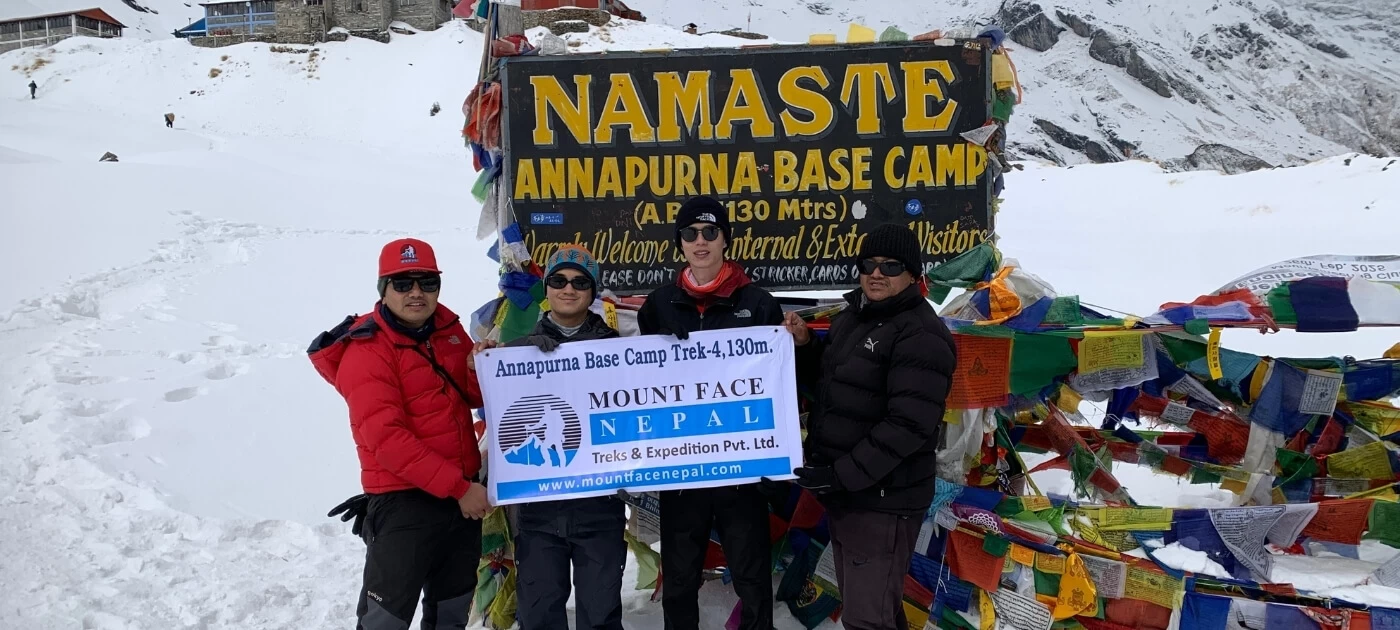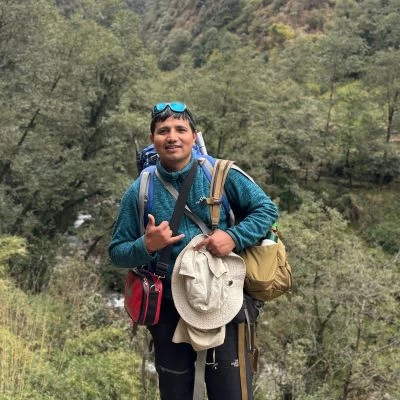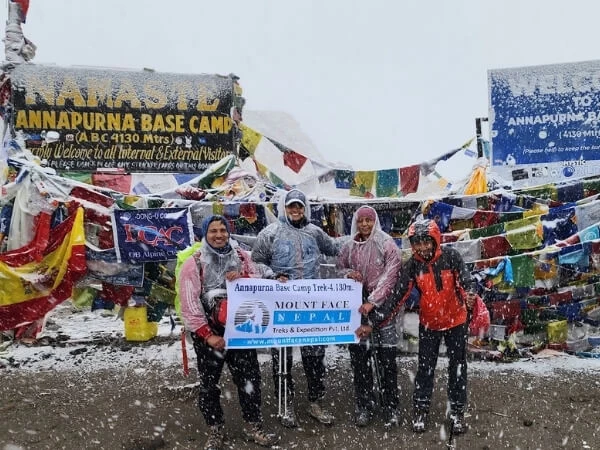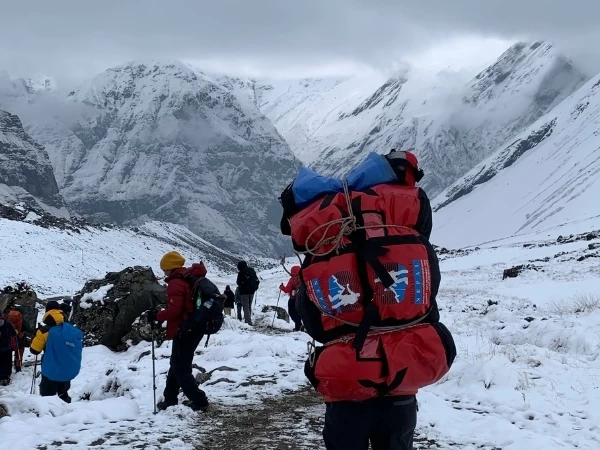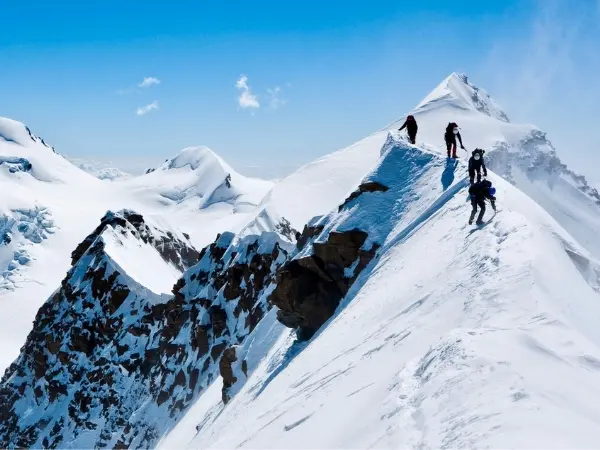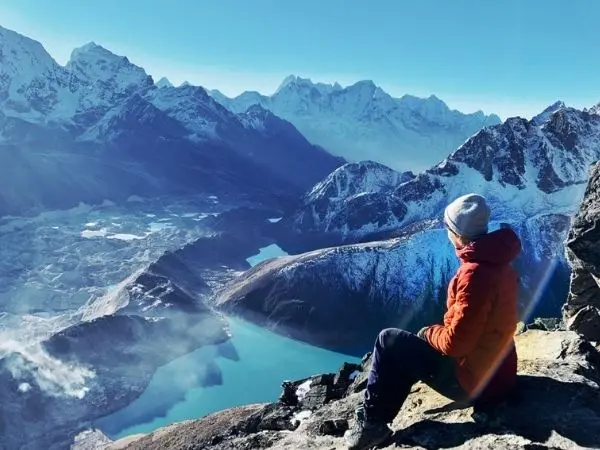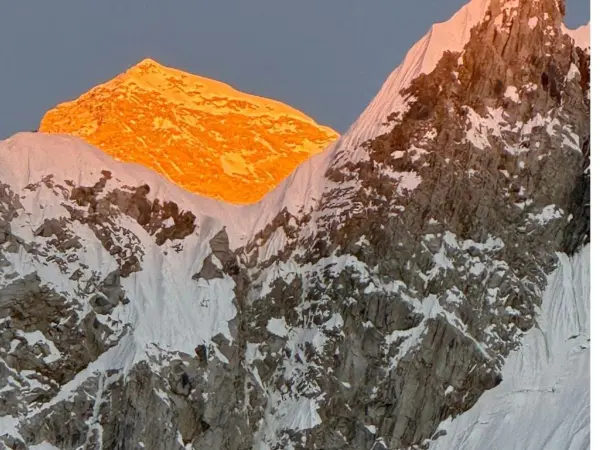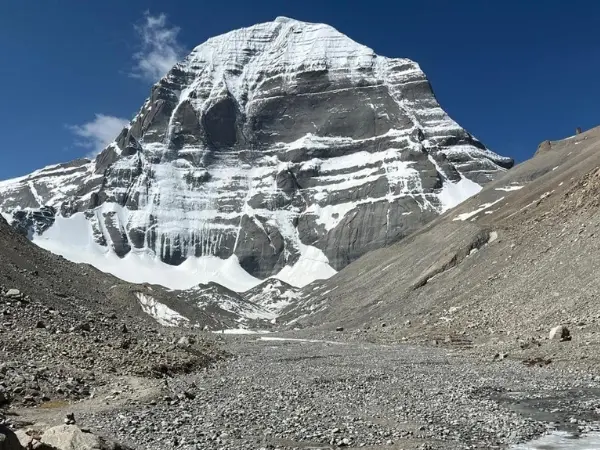Annapurna Base Camp (ABC) is a prominent trekking destination in the Himalayas of Nepal, renowned for its stunning landscapes and diverse natural beauty. Trekkers can experience various ethnic villages, rich cultural heritage, and a range of flora and fauna. The base camp provides breathtaking panoramic views of the surrounding peaks, including Annapurna South, Hiunchuli, and Machapuchare (Fishtail).
Annapurna Base Camp Elevation
Annapurna Base Camp trek is situated at an elevation of approximately 4,130 meters (13,550 feet) above sea level. This altitude places it within the high-altitude zone, where trekkers are rewarded with spectacular views.
The high-altitude setting of Annapurna Base Camp (ABC) ensures expansive and unobstructed views of the surrounding mountains and glaciers, making it a highlight of the trek.
Best Time for Annapurna Base Camp Trek
Spring (March to May)
Weather: Generally stable, with clear skies and mild temperatures. This period offers excellent visibility and fewer weather-related disruptions.
Flora: Rhododendron and other wildflowers are in bloom, adding vibrant colors to the scenery.
Crowds: It’s a popular time, so expect more trekkers, but the trails are well-maintained and lively.
Autumn (September to November)
Weather: Clear skies and cooler temperature provides stunning views. The weather is generally stable, although it can be a bit cooler at higher elevations.
Views: The air is crisp and clear, offering some of the best panoramic views of the mountain.
Crowd: This period also sees many trekkers, but the trails are less crowded than during the spring season.
Preparing for Annapurna Base Camp Trek
Preparing for the Annapurna Base Camp (ABC) trek in Nepal involves several key steps tailored to unique conditions and requirements of trekking in the Himalayas to ensure a safe and enjoyable experience, such as physical preparation, proper gear and equipment, permits and documentation, health and safety, travel logistics, and cultural preparation.
What to pack for Annapurna Base Camp Trek?
Packing the Annapurna Base Camp (ABC) trek requires careful consideration of the diverse and changing conditions you will encounter. Here is a comprehensive packing list:
Clothing
Base Layers: Moisture wicking long sleeves shirts, Lightweight thermal tops, and bottoms
Insulating Layers: Fleece jackets or wool sweaters, Down jackets,s or synthetic insulated jackets for warmth.
Outer Layers: Waterproof or windproof jacket, Waterproof and breathable pants.
Trekking Pants: Lightweight, quick-drying trekking pants and convertible pants (optional)
Headwear and Gloves: Warm hat or beanie, lightweight gloves and heavier insulated gloves or mittens, buff or neck gaiter.
Footwear: Sturdy, waterproof boots with good ankle support, comfortable trekking socks (bring several pairs), lightweight camp shoes, or sandals.
Gear and equipments
Backpack: A 40-50 liter trekking backpack with rain cover
Sleeping Gear: Sleeping bag rated for cold temperatures and sleeping pad for added comfort
Trekking Poles: Adjustable trekking poles for added stability and support
Water: Water bottles or hydration system, Water purification tablets or a file
Personal Items
Toiletries: Biodegradable soap, toothbrush and toothpaste, sunscreen, and lip balm with SPF ( Sun Protection Factor), and hand sanitizer
First Aid Kit: Basic first aid supplies( bandages, antiseptic wipes, blister treatment), Medication for altitude sickness, pain relief and digestive issues
Sun Protection: Sunglasses with UV protection, Wide-brimmed hat
Camera and Electronics: Camera with spare batteries and memory cards, phone with a power bank or extra battery
Documents: Passport and copies, permits ( TMC and ACAP), travel insurance details
Miscellaneous: Snacks and energy bars, lightweight, quick-drying towels, zip lock bags or dry bags for protecting items from moisture
Ensure your pack is well organized and not overly heavy. Prioritize layering and items that offer versatility, and remember to check the weather forecast and adjust your packing list accordingly.
Accommodation during the ABC Trek
The ABC (Annapurna Base Camp) trek in Nepal offers a range of accommodation options, primarily in teahouses or lodges along the trail. Here is a general idea of what you can expect:
1. Pokhara: As the starting point, you can find a wide range of hotels and guesthouses, from budget to luxury.
2. Bamboo: Basic teahouses provide simple rooms with shared bathrooms.
3. Dovan: Similar to bamboo, teahouses here are basic amenities.
4. Himalaya: Basic lodges are available, with simple rooms and shared facilities.
5. MBC (Machhapuchare Base Camp): Teahouses here are basic but can be a bit more crowded.
6. ABC (Annapurna Base Camp): At the base camp itself, accommodation is very basic with shared rooms and communal bathrooms.
The quality of accommodation generally decreases as you go higher up, but the service is usually friendly and the views are spectacular. It’s a good idea to book in advance during peak season to secure your spot.
Food on the Annapurna Sanctuary Trek
On the Annapurna Sanctuary trek, you will find a variety of food options available at teahouses and lodges along the trail. The cuisine typically caters to trekkers and includes a mix of local and international dishes. Here is a detailed look at what you can expect:
Breakfast Options:
Porridge and Cereal: Often served with milk or yogurt.
Pancakes and French Toast: Commonly available with honey, jam, or fruit.
Eggs: Cooked in various styles (boiled, fried, omelets).
Bread and Butter: Sometimes with jam or cheese.
Muesli: Often served with yogurt.
Lunch and Dinner Options:
Dal Bhat: A traditional Nepali meal of rice, lentil soup (dal), vegetables, sometimes fish or meat.
Mo Mo: Nepali dumplings filled with meat or vegetables.
Noodles: Fried or Soup versions, including options chowmein or instant noodles.
Rice Dishes: Variants like fried rice or rice with curry.
Vegetable Curries: Made with local vegetables and spices.
Meat Dishes: Including chicken, buffalo, or sometimes yak prepared in various styles.
Snacks and Beverage
Tea and Coffee: Available throughout the trek, often served with milk or sugar.
Biscuits and Chocolates: Commonly sold at teahouses.
Energy Bars: Sometimes available in larger villages or towns.
Chips and Peanuts: Often found at teahouses for snacking.
Fruits: Such as apples or oranges, though availability can vary based on altitude.
Juices and Soft Drinks: Limited but sometimes available at lower altitudes
The food quality and variety improve as you trek to lower altitudes and more developed teahouses. In higher altitudes, options become more basic due to limited access to supplies. Always check with the teahouse staff about the availability of specific dishes, as offerings can vary along the trek.
Availability of Drinking Water along the ABC Trekking Route
On the Annapurna Base Camp (ABC) trek, it’s important to stay hydrated, but water sources can be a concern. Staying hydrated is essential for acclimatization and overall well-being during the trek.
Drinking water availability along the Annapurna Base Camp (ABC) trek varies depending on the altitude and location. Here is a detailed overview:
Lower Altitude (Pokhara to Chhomrong): Water is readily available in the villages and teahouses. The lower altitude means more frequent settlements with established water supplies. These areas are more populated and have access to natural water sources like rivers and streams. The water is generally considered safe to drink if treated. The cost of water is also cheaper.
Mid-Altitude (Chhomrong to Bamboo): Water sources are still available, but the frequency of teahouses and villages is decreasing. Many teahouses provide water for purchase and offer boiled water. As you ascend, the number of settlements reduces, which impacts the availability of both freshwater sources and amenities. Water sources in this region may be less reliable, so purifying water is essential.
High Altitude (Bamboo to Machapuchare Base Camp): Water sources are scarce. Teahouses and lodges provide water, often for a fee. You may encounter streams or small rivers but should purify this water before drinking. The increasing altitude limits natural water sources. Snow and ice are present at this level, but natural streams are fewer and less reliable. Human activity can impact water quality, so purification is critical.
ABC (Annapurna Base Camp) and above: Water is less available, with few teahouses. Most trekkers rely on water provided by the limited number of lodges, which often charge for it. The higher altitude means fewer settlements and less natural water flow. The water you may find at this elevation may be from melted snow. Ensure you carry adequate purification methods as natural sources may contaminated.
General Tips:
Purification: Always purify water from natural sources using tablets, filters, or UV purifiers to avoid waterborne diseases.
Boiled Water: Many teahouses offer boiled water, which is a safe and convenient option for hydration.
Water Carrying: Carrying sufficient water bottles or a hydration system, especially in higher altitudes where access to water is limited.
Planning and being prepared for varying water availability is crucial for staying hydrated and healthy on the ABC (Annapurna Base Camp) trek.
How difficult is Annapurna Base Camp Trekking?
The Annapurna Base Camp (ABC) trek in Nepal is considered moderate in terms of difficulty, but it still requires good physical fitness and preparation. Here is a breakdown:
Physical difficulty
Fitness level: Requires moderate physical fitness. Regular walking or hiking is beneficial.
Daily duration: Trekkers usually walk 5 to 7 hours per day, with some days being longer.
·Altitude
Maximum Height: Reaches 4,130 meters (13,550 feet) at base camp.
Altitude Sickness: The risk of altitude sickness exists, but it’s lower compared to higher treks like Everest Base Camp.
Terrain
Condition: Includes a mix of well-maintained paths, rocky sections, and steep ascents and descents.
Weather Impact: This can be challenging due to weather conditions, including rain, snow, and mud.
Experience Needed
Previous Trekking Experience: Beneficial but not mandatory. Experience in trekking or hiking at higher altitude helps.
Overall, the trek is manageable for those with average fitness and some trekking experience, but preparation and acclimatization are crucial. It’s still a challenging and rewarding adventure.
Permits required for ABC Trekking
For the Annapurna Base Camp (ABC) trek, you will need the following permits:
Annapurna Conservation Area Permit (ACAP):
Purpose: This permit is required for trekking in the Annapurna Conservation Area, which covers the Annapurna region.
Cost: NPR 3000 for foreigners. For Indian NPR 1500
Where to Obtain: Can be obtained in Kathmandu or Pokhara, or at the entry points to Annapurna Conservation Area.
Documents Required: Passport and passport-sized photo.
Trekker’s Information Management System (TMS) Card:
Purpose: The TIMS card helps the authorities track trekkers for safety and security reasons.
Cost: 2000 NPR for foreigners. 1000 For Indian
Where to obtain: Available in Kathmandu or Pokhara from the Nepal Tourism Board or registered trekking agencies.
Documents Required: Passport, passport-sized photo, and potential proof of travel insurance.
Procedure: In Kathmandu or Pokhara: You can arrange for these permits through a registered trekking agency or directly at the relevant offices. Agencies often handle permit arrangements as part of their services.
Entry points: Permits are checked at entry points such as Nayapul and Tikhe dhunga.
Tips
Permits are Essential: Make sure to obtain all the necessary permits before starting the trek, as they are mandatory for the legal trekking in the region.
Carry Copies: Keep photocopies of permits, passport, TIMS card incase the original is lost or stolen.
These permits ensure you are trekking in a regulated and safe environment while contributing to the conservation of the area and supporting local communities.
Availability of Phone Connectivity, Wi-Fi and Equipment charging during ABC trek
During Annapurna Base Camp (ABC) trek, you can generally find phone connectivity, Wi-Fi, and equipment charging, though availability and quality can vary:
Network Coverage:
Main Area: Coverage is usually good in major villages such as Nayapul, Pokhara, Tikhedhunga, Ghorepani and Chhomrong. These areas have relatively strong signals from major Nepali mobile providers like Ncell and Nepal Telecom.
Remote Area: As you move further along the trek, particularly past Ghorepani and into more remote regions, the network signal can become weaker and less reliable. Coverage may be spotty or intermittent.
Tips for Connectivity
SIM Cards: It’s helpful to get a local SIM card from Ncell or Nepal Telecom in Kathmandu or Pokhara before starting the trek. These SIM cards generally provide better coverage and data services in Nepal.
Backup Communication: For remote areas with poor or no network coverage, consider carrying a satellite phone or messaging device like a Garmin inReach, especially if you are trekking alone or in very remote areas.
Emergency Use
In case of Emergency: While mobile signal may be limited in some areas, major villages usually have access to some form of communication for emergencies.
Overall, while phone network coverage is available along most of the ABC trek, it’s important to plan for areas with potentially weak signal and consider alternative communication options if needed.
Wi-Fi
Availability: Wi-Fi is available in many teahouses and lodges along the route. However, the quality and speed can be inconsistent due to limited bandwidth and high demand from trekkers.
For sure, MBC and ABC have stronger Wi-Fi networks.
Cost: Wi-Fi access is typically not free and may require a small fee or be part of a service package offered by the teahouse.
Equipment Charging
Charging Facilities: Most teahouses and lodges provide charging facilities for electronic devices. This is usually done via solar power or generators.
Cost: There is often a fee for charging devices, which can range from a few dollars to around $5 to USD 10 per device, depending on the lodge and your usage.
Availability: Ensure you carry appropriate charging adaptors and power banks, as access to electricity can be limited in more remote areas.
General Tips for Charging Your Electronic Device
Power Banks: It’s wise to bring a fully charged power bank to keep your device powered throughout the trek, as charging opportunities may not always be convenient.
Portable Solar Panel: It is really helpful to charge your device. It saves your money and reduces the stress of not having backup.
Be prepared for inconsistencies: Expect that connectivity and charging facilities might not be as reliable as in urban areas.
Overall, while you can stay connected and keep your devices charged during the trek, preparing for limited or variable services will enhance your trekking experience.
Is the Annapurna Base Camp Trek suitable for Beginners?
Yes, the Annapurna Base Camp (ABC) trek can be suitable for beginners with some preparation and reasonable fitness. Here is why it is often considered a good option for novice trekkers:
1)Moderate Difficulty
Trial Conditions: The trek involves a mix of well-maintained paths, rocky sections, and some steep ascents. It is not technically demanding, making it accessible for beginners who are in good physical condition.
Duration: The trek usually lasts between 7 to 12 days, allowing for gradual acclimatization and easier adjustment to trekking demands.
2) Altitude
Maximum height: ABC is at 4,130 meters. This altitude is lower than some other high-altitude treks, reducing the risk of severe altitude sickness.
Acclimatization: The trek includes rest days and gradual ascents to help with acclimatization, which is important for beginners to minimize altitude-related issues.
3) Support and Facilities
Teahouses: The trek passes through numerous teahouses and lodges that offer basic but comfortable accommodations. This reduces the need for camping and makes the trek more accessible for novices.
Guides or Porters: Hiring a guide or porter can greatly assist with navigation, carrying gear, and handling logistical aspects, which can be beneficial for beginners.
Preparation and acclimatization are essential for a smooth experience. Ensuring you have a proper gear, a good level of fitness, and an understanding of altitude sickness can make the trek more enjoyable and manageable for beginners.
What makes trekking to ABC worthwhile?
The trek offers unparalleled views of the Annapurna massif, including Annapurna South, Annapurna I, Dhaulagiri Mountain ranges, and the iconic Machhapuchare (Fishtail). The panoramic views from the base camp are among the most spectacular in the Himalayas. The trek brings you within proximity to some of the world’s highest mountains, offering unique perspectives that are hard to find elsewhere.
The trek transitions through a range of landscapes- from lush forests and terraced fields to alpine meadows and glacier valleys. This diversity enriches the trekking experience. Depending on the season, you might encounter blooming rhododendron forests in spring or snow-covered trails in winter, each providing a distinct beauty.
The trek allows you to experience the culture and hospitality of local Gurung and Magar communities, offering insight into their traditional way of life, and customs. Trekkers can experience traditional cuisine while staying in local teahouses while observing daily life offering immersive cultural insights that enhance the journey.
The trek traverses’ different ecological zones, offering opportunities to see diverse wildlife and plant species, including rhododendrons in bloom, forests of oak, and unique high-altitude shrubs. You may spot various wildlife, such as the Himalayan Thar, langur, monkeys and diverse bird species on the section of the trek.
Reaching the base camp at 4,130 meters is a notable achievement, especially for those who may be new to high-altitude trekking. The sense of reaching such a significant point is rewarding and fulfilling. The trek also allows for physical and mental growth, contributing to a sense of personal achievement.
The trek is relatively accessible compared to other high-altitude treks, making it suitable for those with a moderate level of fitness and previous trekking experience.
Overall, the Annapurna Base Camp trek offers a blend of natural beauty, cultural richness, personal challenge and rewarding experiences that make it a standout adventure in the Himalayas.
Annapurna Base Camp trek cost?
For a trek to Annapurna Base Camp (ABC) trek can vary depending on various factors such as the time of year, the trekking agency you choose, and the inclusions in the package. Here is a general review:
Permits
Annapurna Conservation Area Permit (ACAP): 3000 NPR
Trekker’s Information Management System (TIMS) Card: 2000 NPR
Accommodation
Teahouses/Lodges: $5 to USD 15 per night
Meals
Breakfast, Lunch, and Dinner: $15 to USD 25 per day
Guide and porter
Guide: $ 20 to USD 30 per day
Porter: $ 15 to USD 25 per day
Transportation
Kathmandu to Pokhara (by bus): $10 to USD 20
Pokhara to Nayapul (by jeep): $10 to $20 USD
Trekking Package (if booked through an agency):
Standard Package: $600 to USD 1200 (usually includes permits, guide, porter, accommodation, and meals)
Additional Costs:
Travel Insurance: $50 to USD 100
Gear Rental (if needed): $5 to USD 10 per day
Overall, a budget trek can cost around $500 to USD 700, while a mid-range trek with a package might range from $800 to USD 1,200.
Is Annapurna Base Camp harder than Everest Base Camp?
Everest Base Camp is at a higher altitude (5,364 meters) compared to Annapurna Base Camp (4,130 meters), which increases the risk of altitude sickness at EBC. However, the lower altitude of ABC means that you might have more physically demanding terrain to contend with.
The trek to Annapurna Base Camp involves more rugged and varied terrain, including steep ascents and descents, which can be physically taxing. While Everest Base Camp is still challenging, it tends to have more gradual paths.
Annapurna’s weather can be more unpredictable and harsher, especially in the winter. This can make the trek more difficult compared to the relatively stable weather conditions in the Everest region.
The trails to Annapurna Base Camp are often narrower and less maintained compared to Everest Base Camp, which can pose additional challenges.
In summary, Everest Base Camp poses a higher risk of altitude sickness due to high altitude, while Annapurna Base Camp tends to be more physically demanding due to its terrain and potentially harsher weather conditions. So, Annapurna Base Camp is generally considered harder than Everest Base Camp.
What is the total distance of the Annapurna Base Camp trek?
The trek to Annapurna Base Camp (ABC) is approximately 115 to 150 kilometers (70 to 90 miles) round trip, depending on the specific route taken.
The trek usually starts from Pokhara and involves walking through various villages and diverse landscapes, gaining significant elevation as you approach the base camp at 4,130 meters (13,550 feet). The trek typically takes about 7 to 12 days, depending on your pace and the number of rest days you take. The trek generally covers around 55 to 75 kilometers (34 to 46 miles) one way, with the return trip covering a similar distance.
What is the difference between Annapurna Base Camp and Circuit?
The Annapurna Base Camp trek and the Annapurna Circuit are two popular trekking routes in the Annapurna region of Nepal, each offering a unique experience.
ABC trek starts from Pokhara passing through villages like Nayapul, Tikhedhunga, Ghorepani, which generally takes about 7 to 12 days and covers approximately 115 to 150 kilometers round trip. Annapurna circuit is longer circuit that begins and end in different places, typically starting in Besisahar and ending in Kali Gandaki Gorge. It typically lasts 12 to 21 days and spans around 160 to 230 kilometers, depending on the route.
The highest point of ABC is at 4,130 meters whereas Annapurna Circuit reaches the Thorong La Pass at 5,416 meters, making it a higher altitude trek. ABC trek focuses on the Annapurna Sanctuary and its surrounding peaks. While Annapurna Circuit includes the challenge of crossing the Thorong La Pass and provides varied landscape views throughout the trek.
ABC trek provides close up views of Annapurna and nearby peaks. It is less culturally varied compared to circuit. Annapurna Circuit travels through multiple ethnic, regions, such as Manang and Mustang, offering a broader cultural experience and chance to see different way of life and landscapes.
In summary, the ABC trek is shorter and focuses on reaching a specific base camp with spectacular views of the Annapurna range, while the Annapurna Circuit offers a more extended trek with varied terrain and cultural experiences, including crossing a high-altitude pass.
Is the Annapurna Base Camp trek safe?
The Annapurna Base Camp trek is generally considered safe, but like any high-altitude trek, it involves certain risks that you should be aware of and prepared for.
While ABC is at a lower altitude than some other treks, altitude sickness can still occur. It’s essential to acclimatize properly, ascend slowly, and stay hydrated. Weather in the Himalayas can be unpredictable. Rain, Snow, and extreme cold can affect the trek.
The trek involves steep ascents and descents, which can be physically demanding. Proper footwear, trekking poles, and preparation can help manage the rugged terrain.
Ensure you are in good physical health before embarking on the trek. Carry a basic first aid kit and consider hiring a local guide or porter for additional safety and support. Be cautious of wildlife and practice good hygiene to avoid gastrointestinal issues.
Overall, with proper preparation, respect for the environment, and awareness of potential risks, the ABC trek can be a safe and rewarding experience.
Why combine with Ghorepani Poon Hill?
The Ghorepani Poon Hill trek offers spectacular sunrise views over the Annapurna and Dhaulagiri ranges from Poon Hill. Adding this section to the ABC trek enhances the variety of landscapes and vistas you experience.
Poon Hill is famous for its panoramic sunrise views, which are a highlight in themselves. Including this in your trek offers an additional memorable experience.
Overall, combining the ABC trek with the Ghorepani Poon Hill trek provides a more comprehensive trekking experience with diverse landscapes, cultural insights, and breathtaking views.
Jhinu Hot springs
Jhinu Hot Springs is a popular stop on the Annapurna Base Camp trek, known for its natural hot springs located near the village of Jhinu Danda. Jhinu Hot Springs is situated approximately a 2 to 3-hour trek from the village of Chhomrong, which is on the route to ABC. It is located along the Modi Khola River.
The hot springs consist of several natural pools with varying temperatures. The mineral-rich waters are said to have therapeutic properties, making it a relaxing place to soothe tired muscles after trekking.
Visiting the hot springs is a great way to relax and unwind after the trek. The natural setting and soothing warm water provide a pleasant break from the trekking routine.
Jhinu Hot Springs offers a relaxing experience and is a worthwhile detour for many trekkers on the Annapurna Base Camp (ABC).
For more Details . Contact mount face nepal
